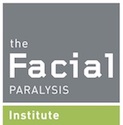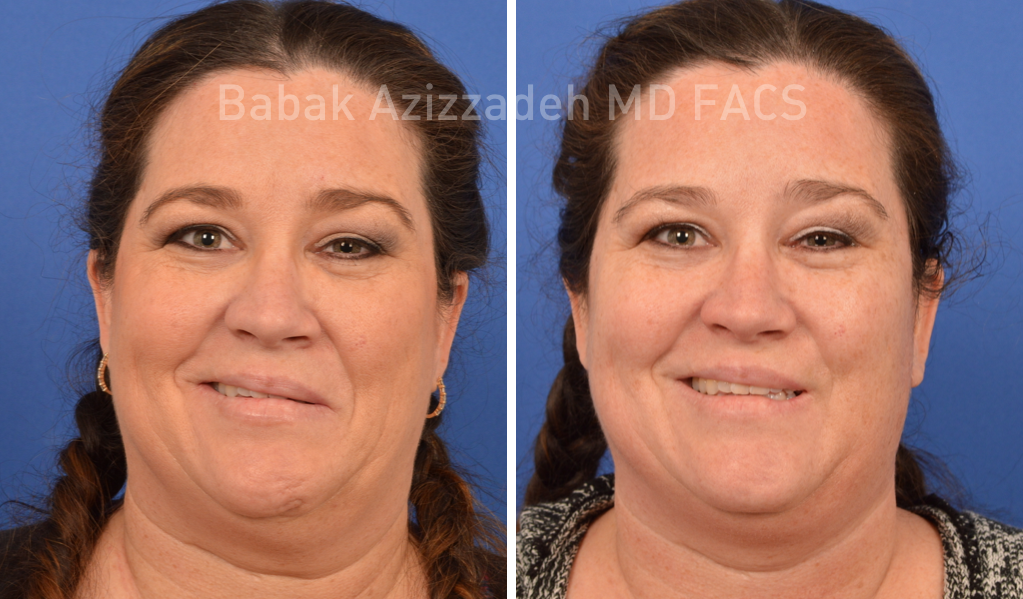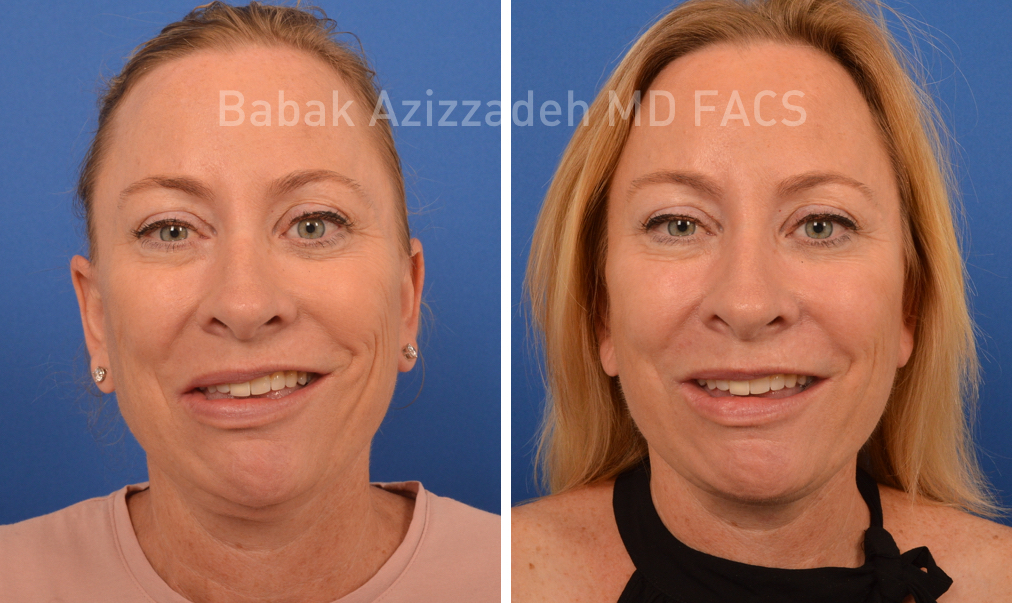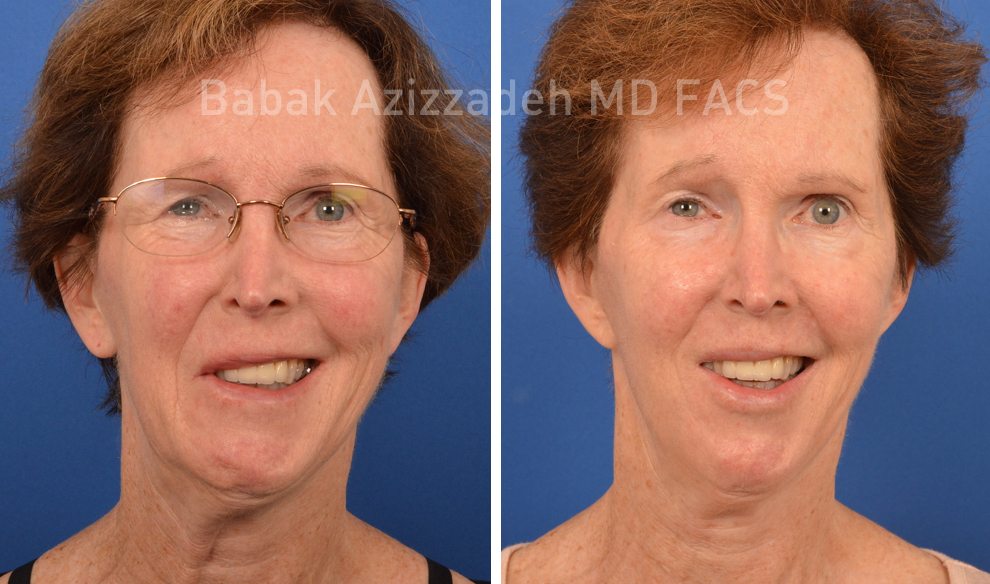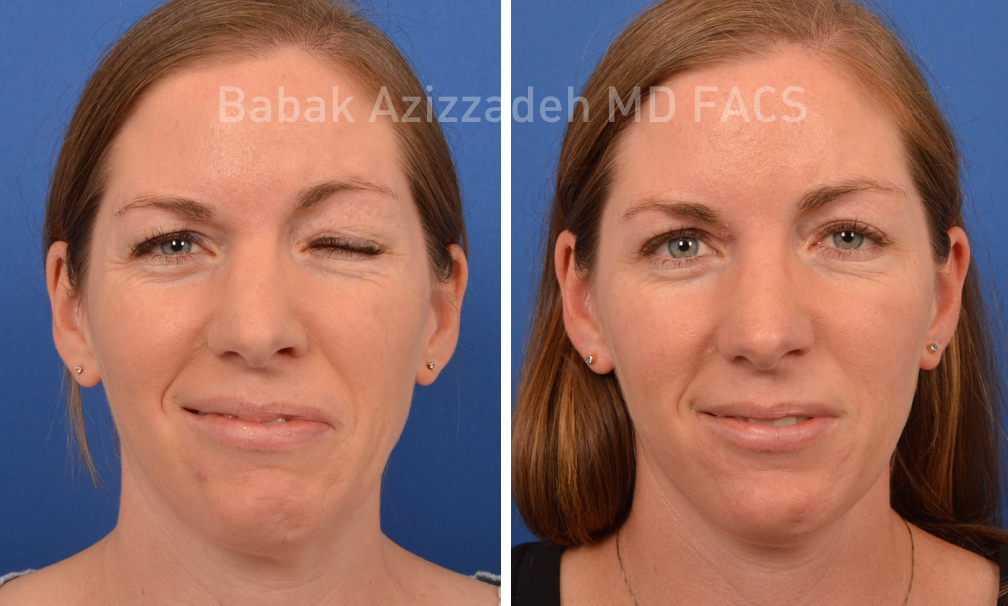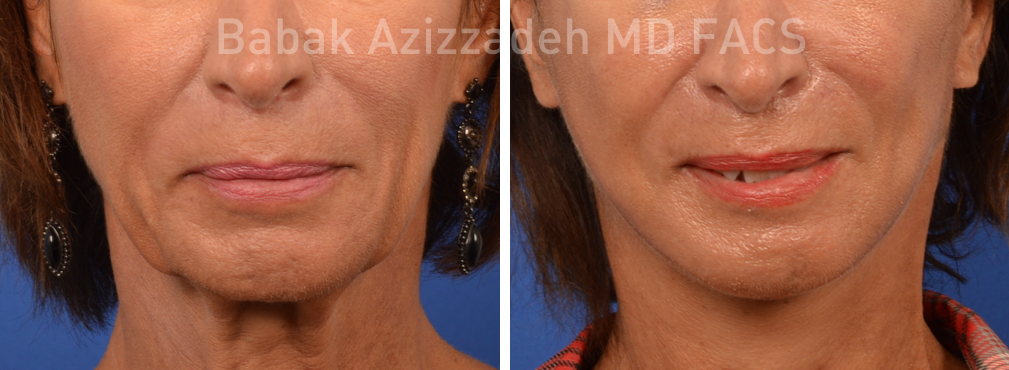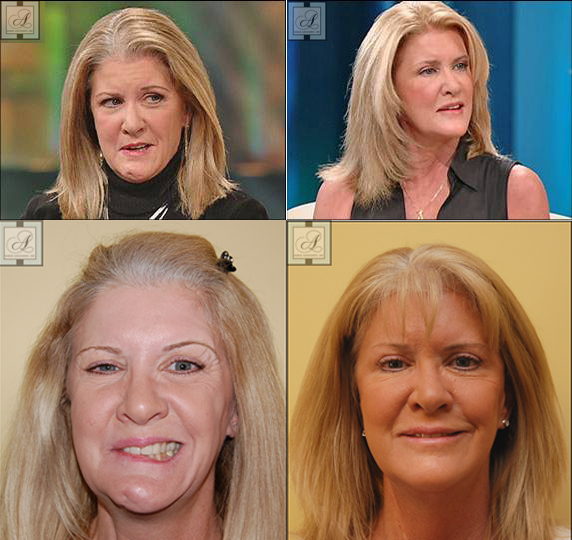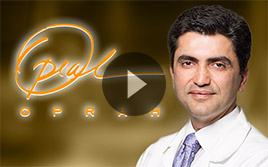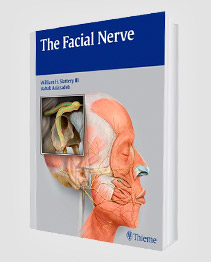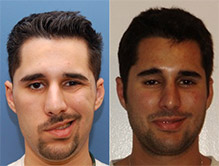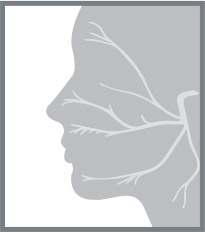Synkinesis refers to the development of unintentional facial movements. Patients dealing with synkinesis can experience facial muscle spasms and other unwanted movements that impact their quality of life.
Selective neurolysis is the best surgical treatment for most patients with partial facial paralysis and synkinesis. Pioneered by globally recognized facial plastic and reconstructive surgeon Dr. Babak Azizzadeh, selective neurolysis and other Facial Synkinesis Treatment offered by Facial Paralysis Institute is safe and effective and provides long-lasting results.
What Is Synkinesis?
Synkinesis is a condition that causes unwanted contractions of the facial muscles. Patients coping with synkinesis may experience forceful eye closure when they try to smile, frown, or make other routine facial movements. If left undiagnosed and untreated, synkinesis symptoms can escalate. In severe cases, synkinesis can cause permanent facial deformities and may need Synkinesis Surgery.
How Is Synkinesis Diagnosed?
A doctor’s consultation is necessary to receive an accurate synkinesis diagnosis. During the consultation, a doctor can examine a patient’s synkinesis symptoms and their medical history, from there he can offer the best Facial Synkinesis Treatment to the patient. The doctor can also assess the facial nerve; to do so, he or she may ask a patient to attempt to make routine facial movements.
It can be challenging to diagnose synkinesis, and early identification of symptoms is vital. If a patient experiences any symptoms of synkinesis and meets with a doctor, he or she can take appropriate steps to address these symptoms before they cause long-lasting harm.
Facial Synkinesis Treatment Options
Treatments are usually based on three modalities:
- Synkinesis Surgery: This may consist of selective neurolysis, static suspension of the corners of the mouth, blepharoplasty (eyelid surgery), or an asymmetric facelift treatment. Partial Facial Paralysis Synkinesis Surgery represents a cutting-edge synkinesis procedure, and it allows a patient to treat their symptoms with minimal recovery time.
- Neuromuscular Retraining (physical therapy): This Facial Synkinesis treatment focuses on retraining the coordination of appropriate facial muscle movements. Neuromuscular training involves the identification of facial muscles that are contracting abnormally, along with a multi-stage process that enables an individual to retrain the facial muscles at the neurological (brain) level.
- Botox (botulinum toxin): This may be used by itself or in combination with selective neurolysis or neuromuscular retraining. Botox for synkinesis can reduce muscle activity, limiting the risks associated with overactive and uncoordinated muscles.
It is essential for a patient to review options for Facial Synkinesis treatment during a consultation with a facial nerve expert like Dr. Azizzadeh. This allows a patient to learn about the benefits associated with each treatment and determine which treatment option will provide the best results based on their unique concerns.
When a patient has tried multiple non-surgical methods to treat their synkinesis symptoms but has not achieved their desired results, Facial Paralysis Synkinesis surgery may be the best option. Dr. Azizzadeh is a Harvard-trained facial paralysis surgeon who can develop a custom surgical treatment plan to address his patient’s synkinesis concerns.
Selective Neurolysis Surgery for Facial Synkinesis Treatment
Selective neurolysis is a revolutionary synkinesis surgery. The procedure can be used to treat patients who cannot generate an appropriate smile due to partial facial paralysis and synkinesis. It is an intricate operation, but the downtime and risks involved are limited in comparison to other facial nerve surgeries.
During selective neurolysis, Dr. Azizzadeh releases the platysma muscle (which pulls the corner of the mouth down, hence preventing upward smile motion). He then selectively decreases the activity of the nerves that counter the smile mechanism to help get an upward trajectory of the mouth and improve synkinesis. The result of this Facial Synkinesis treatment is the spontaneous reanimation of the face.
Benefits of Selective Neurolysis
The benefits of selective neurolysis include:
- Enhanced facial symmetry
- Improved facial muscle coordination
- Reduced facial muscle tightness
Additionally, Synkinesis surgery is a one-stage surgery. Whereas some smile reanimation procedures deliver results that become visible within two to three years of treatment, selective neurolysis produces results that can be seen as soon as one day following surgery.
Synkinesis Surgery Before and After Photos
Check out the photos below to see how past patients have benefited from synkinesis procedures performed by Dr. Azizzadeh.
Static Suspension for Faciel Synkinesis Treatment
Static suspension, or static sling, is a procedure used to improve facial symmetry in patients with facial paralysis and synkinesis, particularly in the mouth and laugh line area. The procedure has been shown to help a patient minimize drooling, biting of the inner gum, and other side effects of facial paralysis and synkinesis.
To perform a static suspension procedure for Facial Synkinesis treatment, Dr. Azizzadeh uses sutures or tensor fascia lata (autologous tendon) from his patient’s outer thigh. If tensor fascia is utilized, strips of the tendon are attached to the corner of the mouth via a small facelift incision. Dr. Azizzadeh uses endoscopic technology to minimize the quantity and size of incisions. The muscle used to create the sling is from the patient’s own body, and there is only a minor chance that the body will reject it.
Another option for Partial Facial Paralysis Synkinesis surgery is to use freeze-dried, acellular human dermis known as Alloderm. Dr. Azizzadeh has experienced great success with Alloderm over the years. One of the benefits of using this Facial Synkinesis treatment is that there is no need for a second incision to harvest muscle.
Dr. Azizzadeh can also perform a minimally invasive suture suspension procedure, which may be a good option for patients with partial synkinesis.
Each patient is unique, and the most-appropriate treatment method for their condition can be decided during a consultation with Dr. Azizzadeh.
Blepharoplasty for Facial Synkinesis Treatment
One of the most common side effects of synkinesis and partial synkinesis is involuntary eyelid closure when smiling, laughing, or opening the mouth. In some cases, this can be treated with a modified blepharoplasty, or eyelid surgery. Depending on your unique situation, Dr. Azizzadeh can customize a Partial Facial Paralysis Synkinesis surgery treatment plan to help restore normal eyelid function and address your specific needs.
Asymmetric Facelift for Facial Synkinesis Treatment
Dr. Azizzadeh can also perform an asymmetric facelift and/or neck lift to improve facial symmetry and minimize the visible effects of facial paralysis and synkinesis. He tailors the facelift to the individual in order to address specific areas affected by synkinesis and obtain optimal aesthetic results.
Dr. Azizzadeh, known around the world for his facial reanimation expertise, performed a facelift on Mary Jo Buttafuoco in 2005 as part of the specialized Facial Synkinesis treatment plan he created to restore balance and animation to her face after she had been shot in the head years earlier. The facelift, performed in conjunction with static facial suspension and a modified blepharoplasty, produced incredible results, both in terms of function and aesthetics.
Cross Facial Nerve Graft & Gracilis Muscle Transplant
Some patients with long-term facial paralysis and synkinesis may be candidates for a cross facial nerve graft and gracilis muscle transplant. These Synkinesis surgery procedures, combined with physical therapy and other Facial Synkinesis treatment, can help restore dynamic facial animation, such as the ability to smile, in facial paralysis patients.
These procedures are typically done in two parts. First, nerve grafts from the lower leg are harvested and fixed to the functioning facial nerve, i.e. the cross-facial nerve graft. The second stage is the gracilis muscle transplant in which a portion of the gracilis muscle free flap from the inner thigh is harvested and attached to the cross-facial nerve graft.
The combination of a cross-facial nerve graft, gracilis muscle transplant, and physical therapy typically restore partial facial movement within eight months. Patients can continue to see improvement for up to two years after treatment.
Synkinesis FAQs
Are facial paralysis and synkinesis identical?
Facial paralysis refers to paralysis of one side of the face. In this instance, the nerves and muscles on one side of the face do not work or move. With synkinesis, the nerves have regenerated incorrectly. Dr. Azizzadeh refers to this as a “mis-wiring.” and can be treated by synkinesis surgery. In this instance, when the patient tries to smile, the wrong muscles are activated and are counteractive to a “normal smile” but don’t worry, there are many Facial Synkinesis treatment options that Facial Paralysis Institute offers for this.
Are Bell’s palsy and synkinesis identical?
Bell’s palsy is a primary cause of facial paralysis in the United States. It results in immediate facial paralysis that generally disappears on its own within about three months of an initial diagnosis. Comparatively, synkinesis may occur after Bell’s palsy.
For those who experience sudden facial paralysis, they should go to an emergency room immediately for Facial Synkinesis treatment. In this instance, it is crucial to meet with a doctor who can perform an evaluation and determine if their patient is dealing with Bell’s palsy and if a Synkinesis surgery is needed.
If a Bell’s palsy patient’s facial paralysis symptoms linger for eight months or longer, a consultation with Dr. Azizzadeh is key. At this point, Dr. Azizzadeh can analyze a Bell’s palsy patient and find out if he or she is dealing with synkinesis. Then, Dr. Azizzadeh can craft a custom Facial Synkinesis treatment to address his patient’s facial paralysis.
What are the symptoms of synkinesis?
An individual who is dealing with synkinesis may experience increased facial muscle tone, short, tight facial muscles, unwanted facial movements and facial movement coordination issues. Other signs of synkinesis include narrowing of the eye affected by facial paralysis, increased facial muscle spasms, dimpling of the chin and tightness of the neck bands and cheeks. Synkinesis symptoms often vary depending on the patient and the severity of his or her condition.
Synkinesis patients may also develop distinct facial muscle patterns. For example, a synkinesis patient’s eye may inadvertently close or twitch when he or she smiles. Or, simultaneously facial muscle movements may cause the corner of a synkinesis patient’s mouth to droop, making it difficult for him or her to smile.
Does synkinesis affect the entire face?
Synkinesis often affects the eyes, cheeks, chin and neck. For synkinesis patients, muscles in these facial areas are difficult to move. As such, synkinesis patients may experience facial twitching and tightness of the facial muscles, among other symptoms.
Is there a Facial Synkinesis treatment one-size-fits-all solution to treat all synkinesis symptoms, at all times?
Every patient we see has a unique case and therefore our treatments are always customized to the needs of each individual patient. To determine the best treatment, Dr. Azizzadeh performs an in-depth patient evaluation prior to recommending a treatment. This evaluation allows Dr. Azizzadeh to assess the patient and determine which Facial Synkinesis treatment option will help a patient alleviate his or her synkinesis symptoms or if Partial Facial Paralysis Synkinesis surgery is needed..
Is synkinesis preventable?
Synkinesis is not preventable, but those who believe they are dealing with synkinesis symptoms can act quickly to minimize their impact. Because the sooner a patient seeks out an expert facial plastic and reconstructive surgeon like Dr. Azizzadeh, the sooner he or she can alleviate these symptoms and find the best Facial Synkinesis treatment suited for them.
How is synkinesis diagnosed?
During an in-person consultation or video inquiry, Dr. Azizzadeh will as the patient to make a series of facial movements. He will watch and evaluate their facial movements to determine the type of synkinesis that is occurring. Once Dr. Azizzadeh determines what nerves and muscles are causing the synkinesis, he then develops a Facial Synkinesis treatment plan for this individual.
What should I expect during a synkinesis consultation?
Dr. Azizzadeh wants his patients to feel comfortable meeting with him and discussing their synkinesis symptoms. During a consultation, Dr. Azizzadeh asks questions to learn about his patient and their symptoms. He evaluates their facial movement capabilities as well.
After a thorough patient assessment, Dr. Azizzadeh provides a Facial Synkinesis treatment recommendation tailored to his patient’s synkinesis symptoms or if Partial Facial Paralysis Synkinesis surgery is needed. He also responds to his patient’s synkinesis concerns and questions and ensures that he or she feels confident about treatment.
How long does it take to administer a synkinesis treatment?
The length of time to administer a treatment varies depending on the procedure. Fortunately, Dr. Azizzadeh provides full details about what a patient should expect during Facial Synkinesis treatment so he or she can prepare accordingly.
How long does it take to see the full results of a synkinesis treatment?
The amount of time before a patient sees the full results of a treatment varies. Dr. Azizzadeh helps each patient plan for a synkinesis treatment. For example, Botox for synkinesis takes about 7 – 10 days to see the results, whereas results from selective neurolysis for synkinesis can be seen in as little as 24-hours post surgery.
What will happen if synkinesis goes untreated?
Synkinesis symptoms may worsen over time and may need Synkinesis surgery. For those who have experienced facial paralysis for at least eight months, a Facial Synkinesis treatment consultation with Dr. Azizzadeh is ideal. By meeting with Dr. Azizzadeh, a patient can receive expert support so he or she can find the best way to permanently address facial paralysis symptoms.
Contact Us Today to Discuss Synkinesis Treatment Options
Dr. Azizzadeh has extensive experience in treating patients suffering from synkinesis, both surgically and non-surgically. He is a dual board-certified facial plastic and reconstructive surgeon who is happy to help patients find ways to manage synkinesis symptoms. Call the Facial Paralysis Institute at (310) 657-2203 contact us online today to schedule an in-person or virtual consultation and begin the road to synkinesis recovery.
Next, read about Botox for synkinesis treatments.
Request your consultation with Dr. Azizzadeh today
Call us at (310) 657-2203 to schedule an appointment.
Schedule a Consultation